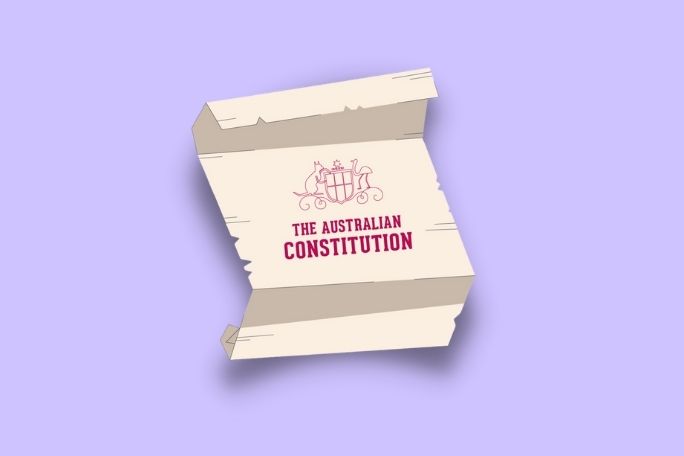Lesson summary
In this Finding Out lesson, students will consider human rights and how they connect with the Australian Constitution. Students will share their opinions about the role of rules and analyse primary sources to better understand the Australian Constitution. They will explore the rights and freedoms addressed in the Constitution and critically assess the human rights that are not enshrined in the Australian Constitution. They will research sections of the Constitution, and share their findings with their peers. Then, using a visible thinking routine, they will reflect on their understanding.
Essential questions:
- What is the connection between rights, freedoms and the Australian Constitution?
- What role do rules play in a democratic society?
- How is the Australian Constitution still relevant today?
Lesson guides and printables
Lesson details
Curriculum mapping
Australian Curriculum content descriptions:
Year 7 Civics and Citizenship:
- The process for Constitutional change through a referendum (ACHCK049)
- The key features of government under the Australian Constitution with a focus on: the separation of powers, the roles of the Executive, the Houses of Parliament, and the division of powers (ACHCK048)
- Identify, gather and sort information and ideas from a range of sources (ACHCS055)
- Develop a range of questions to investigate Australia’s political and legal systems (ACHCS054)
- Critically analyse information and ideas from a range of sources in relation to civics and citizenship topics and issues (ACHCS056)
General capabilities: Literacy, Critical and Creative Thinking.
Relevant parts of Year 7 achievement standards: Students explain how Australia’s legal system is based on the principle of justice. Students explain the diverse nature of Australian society and identify the importance of shared values in promoting a cohesive society. When researching, students develop a range of questions and gather and analyse information from different sources to investigate Australia’s political and legal systems. They consider different points of view on civics and citizenship issues. Students develop and present arguments on civics and citizenship issues using appropriate texts, terms and concepts.
Unit of work: Story of Our Rights and Freedoms – Year 7.
Time required: 120 mins.
Level of teacher scaffolding: Medium – facilitate class discussion.
Resources required
- Student Worksheet – one copy per student
- Device capable of presenting a video to the class
- The Constitution – Image
- Printed copies of Closer Look: The Australian Constitution (produced by the Parliamentary Education Office), separated into four sections
- The Australian Constitution – Chapter Summaries, Australian Constitution and UDHR Comparison Table (printed, enough for one per student), highlighters
Skills
This lesson is designed to build students’ competencies in the following skills:
- Communication
- Empathy
- Initiative
- Leadership
Additional info
Throughout the Story of Our Rights and Freedoms lessons, students will consider Civics and Citizenship concepts through a human rights lens. They will critically assess the Australian system of government and the effect that it has on our rights and freedoms.
There is no universally accepted definition of human rights, and our understanding is continually developing. Some definitions include:
- The recognition and respect of peoples’ dignity
- A set of moral and legal guidelines that promote and protect the recognition of our values, our identity and access to an adequate standard of living
- The basic standards by which we can identify and measure inequality and fairness
- Those rights associated with the Universal Declaration of Human Rights (UDHR)
When we talk about human rights we usually refer to principles that have been agreed upon by countries throughout the world. These rights have been set down in international agreements and form part of international law. They can also be written into the domestic law of individual countries. Human rights cover virtually every area of human life and activity. These include:
- Civil and political rights, such as freedom of speech and freedom from torture
- Economic and social rights, such as the rights to health and education
- Individual rights, including the right to a fair trial
- Collective rights, or those rights that apply to groups of people, such as the right to a healthy environment or to live on one’s ancestral land.
The UDHR is an international document that recognises the basic rights and fundamental freedoms to which all human beings are entitled. It was adopted by the United Nations General Assembly on 10 December 1948 and marks a key milestone in the history of human rights. The Magna Carta, though limited in who it protected, was an important precursor to the UDHR.
Click here to watch a video about the Magna Carta.
You can view the entire text of the Universal Declaration of Human Rights, and the other core international human rights treaties, on the United Nation’s website or by downloading RightsApp (free from the iTunes App store).


Welcome back!
Don't have an account yet?
Log in with:
By signing up to Cool.org you consent and agree to Cool's privacy policy to
store, manage and process your personal information. To read more, please see
our privacy policy here(Opens in new tab).
Create your free Cool.org account.
Many of our resources are free, with an option to upgrade to Cool+ for premium content.
Already have an account?
Sign up with:
By signing up to Cool.org you consent and agree to Cool's privacy policy to
store, manage and process your personal information. To read more, please see
our privacy policy here(Opens in new tab).